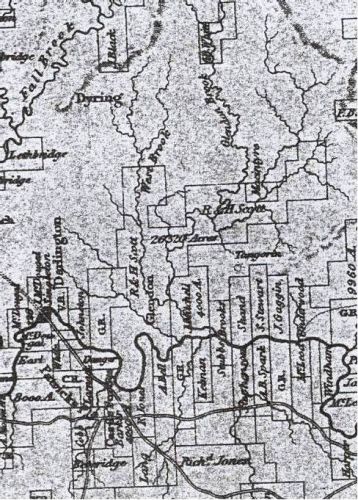James Black and Thomas Steele
St. Clair - Map 4
James Black
James Black was granted 2560 acres of land at Falbrook near Mt. Dyrring on 21 February 1828.A traveller to the Mount Royal in 1885 mentioned James Black:
Many years ago a Mr. Black formed a Merino goat station, but owing either to the unsuitability of the climate, or the sourness of the grass which though plentiful is very coarse, they dwindled away and more than half died. This disheartened him, as well it might, and he eventually left the place, taking with him the remainder of his flock of goats. [2]
Convicts assigned to James Black included:
William Beresford arrived per Susan 1834
John Garvy per City of Edinburgh 1832
Daniel McCarthy per City of Edinburgh 1832
Edward Bourke per Florentia1830
William Heddings per Hooghley 1828
Sarah Shaw per Roslin Castle 1830
William Plant per Marquis of Huntley
John Williams per Fairlie 1834
Thomas Steele
In 1836 this land was re - advertised in favour of Thomas Steele. .....Thomas Steele 2560 acres at Falbrook, near mount Dyrring, commencing at the east bank of Falbrook, (a remarkable bluff point on the west bank, bearing by compass west 20 degrees south) and bounded on the west by a south line by compass of 183 chains; on the south by an east line by compass of 113 chains; on the east by a north line by compass of 240 chains; and on part of the north by a west line of 65 chains to Carrow Brook; and on the residue by Carrow and Fal Brooks, to the point of commencement. Promised on 6th June 1827 by Sir Ralph Darling to James Black and possession authorised on the 21st February 1828, as a primary grant and advertised in his favour on 15th August, 1836, but now re-advertised at his request in favour of Mr. Steele. [1]
Convicts assigned to Thomas Steel at the Mt. Dyrring estate in 1836 - 1837 included
James Holt per Mermaid 1830
William McPhillips per Royal Sovereign 1834
William Beresford per Susan 1834
Edward Bourke per Florentia 1830
Joseph Longman per Claudine 1829
John McBean per Strathfieldsaye 1836
William McIntosh per Surry 1834
James McKay per Fairlie 1834
Francis Miller per Dunvegan Castle 1836
Hamlet per John Barry 1836
William Heddings per Hooghley 1828
Henry Landers per York 1831

Ishmael Jones per Henry Tanner 1834
John Murphy per City of Edinburgh 1832
Cornelius Neale per Hive 1835
Charles Stanyard per Dunvegan Castle 1830
Death
Thomas Steel died after a lingering illness in December 1840.Ludwig Leichardt visited the district in January 1843. The visit to St. Clair is described in Cunninghamia - A journal of plant ecology for eastern Australia -
The journey to St Clair was not without incident. His horse fell with Leichhardt 'violently shaken but broke fortunately no bone'. St Clair station was owned by an absentee owner Thomas Steele. Captain William Colburn Mayne the overseer was not at home when Leichhardt arrived, describing himself as a 'stranger slung around with collecting canisters and boxes.' but with his letter of introduction he was made welcome. The following day the south easterly winds continued, more than likely bringing pleasant slightly cloudy weather and he climbed Mt Dyrring [Dyrrine] to the south overlooking the valley and St Clair. [3]
Arthur Grainger
Many years later, the owner of St. Clair, Arthur Grainer, a well known grazier and prominent member of the Singleton community died after falling from his horse at St. Clair when he was about 57 years of age. NMH 27 March 1919.References
[1] Sydney Monitor 26 December 1836[2] Maitland Mercury 5 May 1885
[3] Fallding, Martinand Benson, Doug, Cunninghamia A journal of plant ecology for eastern Australia, Adventures, hardship and a scientific legacy: Ludwig Leichhardt's 1843 journey to Mt Royal in the Hunter Valley, Land and Environment Planning, Singleton, NSW AUSTRALIA; The Royal Botanic Gardens and Domain Trust, Royal Botanic Garden, Mrs Macquaries Rd Sydney NSW 2000 Australia, 2013, p.308
↑
